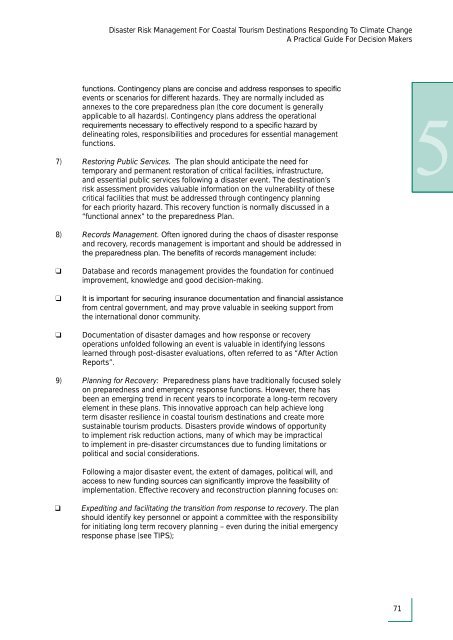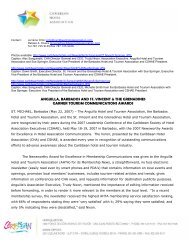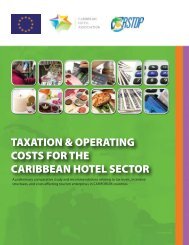Disaster Risk Management for Coastal Tourism - Caribbean Hotel ...
Disaster Risk Management for Coastal Tourism - Caribbean Hotel ...
Disaster Risk Management for Coastal Tourism - Caribbean Hotel ...
You also want an ePaper? Increase the reach of your titles
YUMPU automatically turns print PDFs into web optimized ePapers that Google loves.
<strong>Disaster</strong> <strong>Risk</strong> <strong>Management</strong> For <strong>Coastal</strong> <strong>Tourism</strong> Destinations Responding To Climate Change<br />
A Practical Guide For Decision Makers<br />
<br />
events or scenarios <strong>for</strong> different hazards. They are normally included as<br />
annexes to the core preparedness plan (the core document is generally<br />
applicable to all hazards). Contingency plans address the operational<br />
<br />
delineating roles, responsibilities and procedures <strong>for</strong> essential management<br />
functions.<br />
7) Restoring Public Services. The plan should anticipate the need <strong>for</strong><br />
temporary and permanent restoration of critical facilities, infrastructure,<br />
and essential public services following a disaster event. The destination’s<br />
risk assessment provides valuable in<strong>for</strong>mation on the vulnerability of these<br />
critical facilities that must be addressed through contingency planning<br />
<strong>for</strong> each priority hazard. This recovery function is normally discussed in a<br />
“functional annex” to the preparedness Plan.<br />
5<br />
8) Records <strong>Management</strong>. Often ignored during the chaos of disaster response<br />
and recovery, records management is important and should be addressed in<br />
<br />
<br />
<br />
<br />
Database and records management provides the foundation <strong>for</strong> continued<br />
improvement, knowledge and good decision-making.<br />
<br />
from central government, and may prove valuable in seeking support from<br />
the international donor community.<br />
Documentation of disaster damages and how response or recovery<br />
operations unfolded following an event is valuable in identifying lessons<br />
learned through post-disaster evaluations, often referred to as “After Action<br />
Reports”.<br />
9) Planning <strong>for</strong> Recovery: Preparedness plans have traditionally focused solely<br />
on preparedness and emergency response functions. However, there has<br />
been an emerging trend in recent years to incorporate a long-term recovery<br />
element in these plans. This innovative approach can help achieve long<br />
term disaster resilience in coastal tourism destinations and create more<br />
sustainable tourism products. <strong>Disaster</strong>s provide windows of opportunity<br />
to implement risk reduction actions, many of which may be impractical<br />
to implement in pre-disaster circumstances due to funding limitations or<br />
political and social considerations.<br />
Following a major disaster event, the extent of damages, political will, and<br />
<br />
implementation. Effective recovery and reconstruction planning focuses on:<br />
<br />
Expediting and facilitating the transition from response to recovery. The plan<br />
should identify key personnel or appoint a committee with the responsibility<br />
<strong>for</strong> initiating long term recovery planning – even during the initial emergency<br />
response phase (see TIPS);<br />
71








